Victoria Common Spiders
Spiders Appearance
Eight legs, two body regions, no wings or antennae.
Spiders Behavior, Diet & Habits
Some spiders like moisture and are found in basements, crawl spaces and other damp parts of buildings. Others like dry, warm areas such as subfloor air vents, upper corners of rooms and attics. They hide in dark areas.
They feed on insects, other spiders and any other prey they are able to subdue.
Spiders Reproduction
Females produce an egg sac from which emerge spiderlings. Spiderlings undergo a series of molts and eventually become adults. Males of many spider species court the female. For example, male jumping spiders perform elaborate dances to attract the attention of a female. Mating can be a dangerous event for males, since they may become a meal for the female afterwards.
How Do spiders Get in the Home?
Spiders commonly enter homes in two primary ways: entering through open, poorly screened windows and doors and through cracks and gaps around door and window frames. Most of the time, spiders come inside the home looking for prey. The other common method of entry is accidentally hitchhiking inside boxes, on outdoor items and numerous other things that are brought inside a home or business
Common spider species found in Victoria
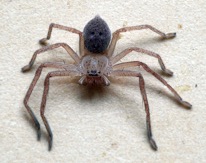
Badge (huntsman ) spider
Neosparassus diana
Habitat and Biology
The badge huntsman is nocturnally active and occasionally comes into houses, but less frequently than other huntsman spiders. Outside it can be found hunting for prey on the trunks of trees or in foliage. During the day it will retreat beneath the bark of a tree. A silken retreat is built in a similar situation for moulting and egg laying. Some species of Neosparassus build a silken retreat in foliage by gluing several leaves together, whilst others construct shallow burrows. The egg sac, which is a flattish silken capsule, is guarded by the female. During this period she can be quite aggressive and will rear up in a defensive display if provoked. Young Neosparassus are often green in colour.
Colour
Male: Similar to female.
Female: Fawn to orange or pinkish brown. Black shield shaped marking with two white spots on underside of abdomen.
Form
Body flattened, though less so than other huntsman groups. First two pairs of legs distinctly longer than hind two pairs.
Body Length
Male: 16mm
Female: 20mm
Web type
Does not build a web.
Bite
No serious symptoms have been recorded from the bite of N. diana, but bites from other species of Neosparassus are known to cause general symptoms including local severe pain and swelling, sweating, nausea and vomiting.
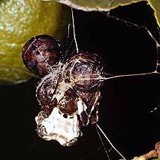
Bird Dropping Spider
Celaenia excavate
Habitat and Biology
This spider has been described as the master of camouflage, its colour pattern resembling a bird dropping. Another common name for the species is the death's head spider, due to the supposed resemblance of the body colours to a skull. The bird-dropping spider is a sedentary spider found sitting on a leaf or suspended underneath its egg cases. The egg cases, numbering up to 13, are large (12-14 mm in diameter), dark brown spheres with black criss-cross markings. This spider feeds at night, almost exclusively on male moths. It sits with forelegs outstretched awaiting the approach of prey. The spider attracts the moth by releasing a sex pheromone or smell similar to that produced by female moths.
Colour
Male: Similar to female.
Female: Body mottled brown, black and cream.
Form
Abdomen broad and triangular, upper surface rising to a pair of roughened humps towards the rear, distinctly concave along midline. Legs folded against body.
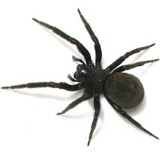
Black House Spider
Badumna insignis
Habitat and Biology
Commonly found around buildings in the corners of window frames and doors, in crevices of brickwork, under eaves, etc. In nature, they are found in holes in tree trunks, crevices in rocks, etc. The distinctive lacy web with funnels is sometimes confused with that of a funnel-web spider, but all species of funnel-web spiders found in Victoria build their retreats at or below ground level. The black house spider is a timid spider and will normally only venture from its retreat when prey is entangled in the web. The prey is then quickly seized and dragged back into the tube. Males wander at night during the mating period. After mating the female lays her silk-encased eggs within the tube. The maximum life span is around two years.
Colour
Male: Similar to female but often slightly paler.
Female: Cephalothorax and legs shiny black, abdomen duller black or grey-black.
Form
Robust, hairy spider with a typically blunt, square front end of the cephalothorax.
Body Length
Male: 10mm
Female: 20mm
Web type
Lacy sheet with one or two funnel-shaped entrances leading into a tubular retreat.
Bite
Because of its timid nature this spider rarely bites humans; however, the bite can cause general symptoms including nausea, sweating, localised pain and swelling.
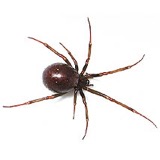
Brown House Spider
Steatoda grossa
Habitat and Biology
There are two species of Steatoda which are known by the name Brown House Spider. These are Steatoda capensis (Hann) and Steatoda grossa (Koch). This spider is often confused with the red-back spider, which has a similar body shape and web structure. Unlike the red-back spider, the brown house spider never has a red hour-glass marking on the underside of the abdomen. The Brown House spider (sometimes known as the Cupboard spider) is often found indoors in dark places, inside or under furniture. It is uncommon to find the red-back spider in such places. Outdoors, the brown house spider can be found in sheds, under empty plant pots or amongst general refuse. Egg sac similar to that of the Red-back spider.
Colour
Male: Smaller-bodied with longer legs; similar colours to female except white markings more prominent.
Female: Overall body colour is brown to black, typically with a dull white crescent-shaped marking on top of the abdomen, sometimes followed by several dull white spots.
Form
Similar in shape to the red-back spider, with pea-shaped abdomen and slender legs.
Body Length
Male: 4mm
Female: 10mm
Web type
Tangled web with sticky catching attached to substrate.
Bite
Unlike the red-back spider the bite of the brown house spider is not lethal, but may cause headaches or nausea. Small blisters may occur around the bite site.
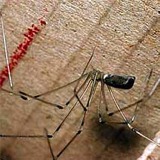
Daddy Long-Leg Spider
Pholcus phalangioides
Habitat and Biology
This spider is commonly found indoors in dark areas, such as behind doors or furniture, disused rooms, etc. Old webs are often seen in the corners of ceilings. Outside it occurs in garages and sheds, under verandahs, etc. Lifespan may vary from three months to two years depending on temperature and food supply. Food consists of small insects, spiders, silverfish, etc. The daddy long-leg spider is usually associated with human habitation and is thought to have been introduced into this country. Harvestmen (Opiliones) are sometimes mistaken as daddy long-leg spiders; however, harvestmen lack a median constriction of the body and are rarely found indoors, preferring moist areas outside. The eggs are held together in a circular bundle with a few silk threads and are carried in the mouthparts of the female until hatching
Colour
Male: Similar to female.
Female: Overall body colour pale brown to cream with darker markings on legs and cephalothorax, sometimes with darker markings on abdomen.
Form
Recognised by its extremely long and slender legs and relatively small body.
Body Length
Male: 16mm
Female: 20mm
Web type
Makes a tangled web, up to 30 cm in diameter, inside shelter locations.
Bite
Relatively harmless; local reaction if any. Folk lore has it that the venom of this spider is extremely venomous.
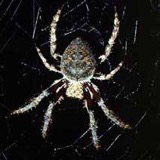
Garden Orb-weaving Spider
Eriophora biapicata
Habitat and Biology
This is a large robust spider which builds a large, strongly constructed orb web to catch its prey of mostly flying insects. The web is usually constructed in the evenings and is sometimes unexpectedly encountered by humans. The spider rests upside down in the centre of the web. At dawn the web is often taken down. The spider then rests on nearby foliage with legs drawn in and is well camouflaged. The eggs, which are laid by the female in late summer to autumn, are encased in a fluffy silken cocoon and attached to foliage. The lifespan of the garden orb-weaver is approximately twelve months. It is a widespread species having been recorded from all states except Tasmania.
Colour
Male: Similar to female.
Female: Bases of legs bright red, rest of legs and cephalothorax reddish brown with long white hairs. Abdomen brown, usually with darker foliate pattern and sometimes with white spots or stripe.
Form
Typically with a triangular abdomen with two noticeable humps towards front.
Body Length
Male: 18mm
Female: 22mm
Web type
Large, strongly constructed orb web.
Bite
The bite of the garden orb-weaver is not considered dangerous. Symptoms may include localised mild pain and swelling, nausea and dizziness.
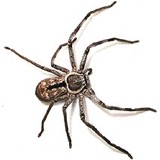
Huntsman Spider
Holconia immanis
Habitat and Biology
This huntsman is the one most commonly found in houses, where it hunts at night on walls and ceilings. It also occasionally enters the cabins of vehicles, causing much alarm. In the bush Holconia can be found sheltering during the day beneath the loose bark of eucalypts. It is a large species and, when alarmed, is capable of moving very rapidly often in a sideways direction. Food consists of insects and other invertebrates. The egg sac is flat, oval and constructed of white papery silk. It is most commonly deposited beneath the bark of trees. Lifespan of the species is about two years.
Colour
Male: Similar to female.
Female: Brown to grey with several pairs of darker spots on upperside of abdomen, sometimes with dark bands on legs.
Form
Body very flattened with long, rather forwardly directed legs. The first two pairs of legs are longer than the second two pairs.
Body Length
Male: 25mm
Female: 40mm
Web type
Does not build a web.
Bite
This is a timid spider and bites are infrequent. Symptoms are minor, including local pain and swelling.
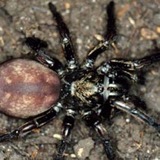
Melbourne Trap-door Spider
Stanwellia grisea
Habitat and Biology
Due to its size, colour and large fangs, these spiders are often thought to be Sydney funnel-web spiders. The Melbourne trap-door spider is a common ground-dwelling spider often encountered by the weekend gardener when digging soil or moving rocks. Both males and females dig silk-lined burrows up to 40 cm deep in soft earth. Despite the reference in the common name, the entrance of the spider's burrow does not have a 'trap-door'. The spiders feed at night, waiting at the entrance of the burrow to ambush passing insects. Males leave the burrow when mature and roam in search of a mate. This roaming usually occurs in autumn or early winter and may take the spider into odd places such as inside houses, swimming pools, etc. Trap-door spiders have long life spans and may live from 5 to 20 years.
Colour
Male: Similar to female except that some specimens have golden hairs on the cephalothorax.
Female: Cephalothorax and legs brown, abdomen often paler with dark, mottled, rib-like pattern on upper surface.
Form
Large robust spiders, males are generally smaller-bodied and longer-legged than females.
Body Length
Male: 25mm
Female: 35mm
Web type
Several strands of silk radiate from around the entrance of the burrow.
Bite
Due the size of the fangs, the trap-door spider can inflict a deep, painful wound, but, the venom is not known to cause medical problems. The two large appendages on the tail of the spider are spinnerets, on which the silk glands open.
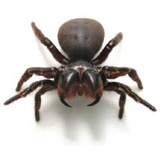
Mouse Spider
Missulena bradleyi
Habitat and Biology
Like the trap-door spiders, the mouse spider lives in tunnels in the ground. Unlike the Stanwellia trap-door spiders, mouse spiders do possess a `trap-door' lid at the entrance. Males are most active during the daylight hours of the early winter, when they search for a mate. A close relative, Missulena occatoria Walckenaer, occurs in the drier western areas of Victoria and males of this species have a distinctive red cephalothorax and black abdomen. The spiderlings of the mouse spider apparently disperse on gossamer, a technique which is rare in mygalomorphs. The common name derives from the erroneous belief that this spider excavated a mouse-like burrow.
Colour
Male: Cephalothorax and legs glossy black, abdomen slightly paler with distinct pale bluish patch on upperside towards the front.
Female: Dark brown to blackish.
Form
Recognised by the large cephalothorax, stout legs, and eye formation spread across the front of the cephalothorax instead of in a compact group as in trap-door spiders.
Body Length
Male: 15mm
Female: 25mm
Web type
Does not build a web.
Bite
Although some experimental evidence suggests the venom of mouse spiders is relatively toxic, most recorded bites have not produced serious reactions.
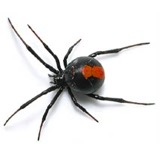
Red-back Spider
Latrodectus hasseltii
Habitat and Biology
This spider is commonly found outdoors around human habitation, in such places as rubbish, litter, old tins, containers, under and on steps of the verandah, and on or under the seats of outdoor toilets! Storage stacks and disused furniture will encourage the breeding of this spider. In nature, it occurs under logs, bark, sides of rocks, etc. As the spider rarely leaves its web, humans are not likely to be bitten unless some part of the body (eg. the hand) is put into the web. Always check before moving items that have been stored outdoors for some time. Wear gloves when cleaning up rubbish areas. The female produces up to ten pale-yellow egg sacs, each with approximately 250 eggs. Females may live for two to three years, males about 90 days.
Colour
Male: Usually without red markings. Body light brown with white markings on upperside of abdomen, and pale hour-glass marking on underside.
Female: Body and legs dark brown to black. Characteristic red hour-glass marking on underside of abdomen, usually also with broad, red stripe on upperside of rear half of abdomen; red stripe sometimes broken. Juveniles recognised by white markings on abdomen.
Form
Characteristic pea-shaped abdomen, long slender legs, males much smaller than females. For more information, see the Queensland Museum Spider Page.
Body Length
Male: 4mm
Female: 10mm
Web type
Tangled web with sticky catching attached to substrate.
Bite
The bite is highly venomous and characterised by intense localised pain and around the bite site. Other symptoms may include sweating, muscular weakness, loss of co-ordination and, in severe cases nausea, vomiting, convulsions, etc. The following envenomation description is from The Australian Animal Toxins by Struan Sutherland, 1983. Signs and Symptoms: The normal sequence of events after a bite is as follows. A sharp pin-pricking pain is almost invariable. Usually the bite site becomes hot, erythema and oedema develop rapidly. Localized sweating often occurs. The swelling is generally limited to an area of several cm in radius from the bite site; occasionally it is extreme. Approximately five minutes after the bite, intense local pain commences and increases in severity and distribution. In most cases, pain is the predominant symptom; the patient is sometimes distraught and even hysterical because of its intensity. Movement of the affected limb often significantly increases the pain. About thirty minutes after the bite, pain and swelling are often experienced in the regional lymph nodes. If abdominal pain occurs, it is worse when the lower extremities or genitals were bitten, probably due to lymph node involvement. Sometimes severe pain develops in parts remote from the bite site, for example, in an opposite limb or the opposite side of the trunk. Uncommon, even bizarre, signs and symptoms developed in some cases. There were tetanic spasms, tingling in the teeth, swelling of the tongue, bite site infection, convulsions, excessive thirst, severe diarrhoea, anaphylactic reaction to the venom, blotchy rash on face, haemoptysis, dyspnoea, dysuria, severe trismus, persistent anorexia, periorbital oedema and/or conjunctivas. Patchy areas of what was described as `bizarre sweating' were not uncommon. For additional information see
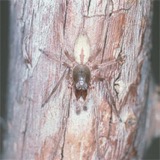
Sac Spider
Cheiracanthium mordax
Habitat and Biology
The sac spider is another vagrant hunter. It makes a silken retreat or sac in which it rests during the day and may be used for moulting and egg laying. In nature, the spider's sac occurs under the bark of trees or amongst foliage. In buildings, the spider's sac is built behind cupboards, pictures etc. The egg mass is deposited in the sac, encased in silk and guarded by the female. The lifespan is not known but is unlikely to exceed two years.
Colour
Male: Similar to female but often slightly darker overall.
Female: Cephalothorax and legs pale brown, abdomen cream with darker longitudinal stripe on upperside.
Form
Small, stout-bodied spiders with slender legs; male has remarkably enlarged jaws giving it a rather unusual appearance.
Body Length
Male: 9mm
Female: 10mm
Web type
Does not build a web.
Bite
The bite of this spider may cause general symptoms including local pain and ulceration, nausea, faintness and headache.
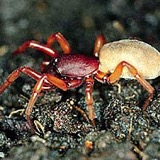
Slater-eating Spider
Dysdera crocata
Habitat and Biology
As its name suggests, the slater-eating spider prefers a diet of slaters (or wood-lice) which it captures with specially elongated fangs. It is believed to have been introduced into Australia from Europe and only occurs in the south-eastern part of the continent. It prefers damp habitats under logs, rocks, rubbish etc., places it is most likely to encounter prey. It is relatively common in urban gardens. Apparently this spider has a strong aversion to ants, which limits its distribution in this country. The slater-eating spider builds a silken sac-like retreat in which it rests, moults and lays eggs. The eggs are wrapped in silk and guarded by the female until hatching.
Colour
Male: Similar to female.
Female: Cephalothorax and legs reddish brown, abdomen cream to pale grey.
Form
Body cylindrical, abdomen stout, fangs noticeably elongated and projecting forward.
Body Length
Male: 11mm
Female: 14mm
Web type
Does not build a web.
Bite
The bite not considered dangerous but causes itchy local reactions.
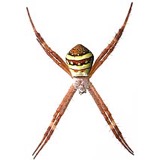
St Andrew’s Cross Spider
Argiope keyserlingii
Habitat and Biology
The St Andrew's Cross spider commonly builds its web amongst shrubs and other vegetation or against walls of buildings. It normally hangs upside down in the web with two paired legs placed along each arm of the cross. The silken cross may be used for strengthening the web, for camouflage or for enhancing prey catches. It has been shown that the cross reflects ultra-violet light which is particularly attractive to insects. Egg sacs are pear-shaped, green in colour and are suspended in nearby vegetation rather than in the web itself.
Colour
Male: Cephalothorax and legs brown; abdomen cream with a mottled brown pattern.
Female: Cephalothorax brown and covered with silky hairs. Abdomen with horizontal stripes of yellow and crimson brown, sometimes with pale spots on the brown stripes. Legs dark brown to black with a few yellowish bands.
Form
Small-bodied with relatively long legs; often appears to have only four legs due to resting position in web. Male much smaller than female.
Body Length
Male: 4mm
Female: 20mm
Web type
Orb web with a cross of thick silk through its centre.
Bite
The bite of this spider is considered harmless or at most to cause a weak local reaction. Few bites have been recorded.
